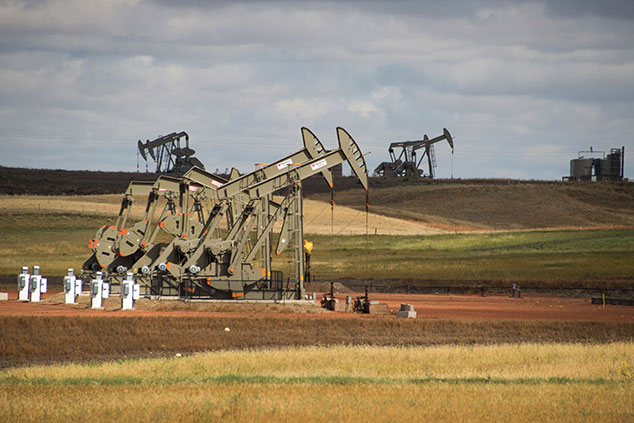
This article is taken from our FREE daily investment email Money Morning.
Every day, MoneyWeek’s executive editor John Stepek and guest contributors explain how current economic and political developments are affecting the markets and your wealth, and give you pointers on how you can profit.
Quick note to MoneyWeek subscribers: if you haven’t booked your ticket for the MoneyWeek Wealth Summit yet, then have a look in this week’s issue of the magazine when it hits your doorstep – there’s a special subscriber discount offer. We’ll also be announcing more guests very shortly – keep an eye out for that.
Equity and bond markets have calmed down a little after the drama of earlier in the week.
There’s not a hugely obvious reason for this beyond the fact that markets can only sustain so much panic before they get tired.
So let’s quickly turn to another key asset that took a hammering this week.
Oil.
Oil is in a bear market
The price of oil has been hit hard in recent weeks. At the tail end of last month, Brent crude (the European benchmark) was trading at over $64 per barrel. As of this morning, it’s trading at around $57 a barrel. The drop was even harder for WTI, the US benchmark. It’s fallen from around $58 a barrel to below $53 this morning.
What’s going on? I suppose it’s pretty obvious. Recession and slowing growth mean a drop in demand for oil (or at least a drop in the rate of demand growth). If demand weakens more rapidly than supply, then prices fall.
Of course, it’s never that simple with oil, because there’s a lot of speculation and not entirely reliable data thrown into the mix. Not to mention things like unexpected production cuts, or flaring tension in the Middle East (which never goes away, but matters more some days than others).
But overall, the outlook is not a pretty one for oil producers, it seems. The International Energy Agency (IEA) has just come out with a report that suggests that oil demand growth in the first five months of 2019 was the worst it’s seen since the same period in 2008. Now we all know what happened in 2008, so that’s not a soothing statistic.
What’s it down to? Trade tension and slowing growth. The IEA previously reckoned that oil demand in 2019 would grow by 1.5 million barrels of oil a day. It now reckons growth will come in at just 1.1 million barrels per day. That’s nearly a third off – and it’s still one of the more optimistic views out there.
Meanwhile, supply has more than kept up. Oil cartel Opec has cut production by two million barrels a day over the past year, says the Financial Times. But growth elsewhere – mostly from US shale oil – is set to almost entirely offset that this year.
As a result, oil is now firmly in a bear market, with Brent down by more than 20% since April, notes the Financial Times.
I hate to say it, but oil could go either way
So what could happen next? The problem with oil right now is that you can make lots of fundamental arguments for big moves in either direction. It’s not blatantly cheap or hated as it was back when it dived to $30-odd a barrel in 2016. Yet it’s not obviously expensive either.
On the one hand, if we’re heading into a recession and a slowdown – which seems very possible – then oil could go lower from here. China is particularly important. As Gregor Macdonald in The Gregor Letter points out, Chinese vehicle demand has dropped in the first five months of this year, and so has fuel consumption. Meanwhile “US gasoline demand… is putting in a third year of no-growth.”
There’s also the issue of shale production. Opec can cut as much as it wants, but much of the shale production is now in the hands of the oil majors, who have a better ability to sustain losses in shale production because they can offset it elsewhere.
On the other, if we get a surprise on the trade front, or we get central banks loosening monetary policy in a highly aggressive manner (yes, they look as though they’re struggling right now, but every single other time investors have thought that since 2008, they’ve pulled rabbits from hats) then maybe the gloom is overdone.
My colleague Dominic is bullish on oil for the long run. I’m ambivalent, I have to say. I struggle to have a high conviction view on oil here. It has a habit of making big sudden moves which is one very good reason to be circumspect about staking money on what it might do next.
But at the same time, I don’t see a compelling reason to ditch your exposure to it (particularly as Dominic’s favourite play is BHP Billiton, which also has exposure to lots of other commodities).
I realise that’s not very satisfying, but I have to be honest about it. It’s one of those ones that could go either way. In the longer run, I think that having more oil in the hands of more reliable trading partners, combined with a rise in electrification, could be an absolutely brilliant boon to the global economy.
But right now, the slide in prices is being driven more by fear of a slowdown – so an ongoing collapse would probably be a warning sign. We’ll have more on oil in tomorrow’s Money Morning where we run through our “charts that matter”.
PS If you’re in Edinburgh this month (or you’re thinking of going), don’t miss our show at Adam Smith’s former residence, Panmure House. Dominic Frisby, then Merryn Somerset Webb (from 17 August) are hosting panel discussions on the biggest issues of the day with various great minds in attendance (oh and I’ll be there on 22nd and 23rd). Get your ticket here now.